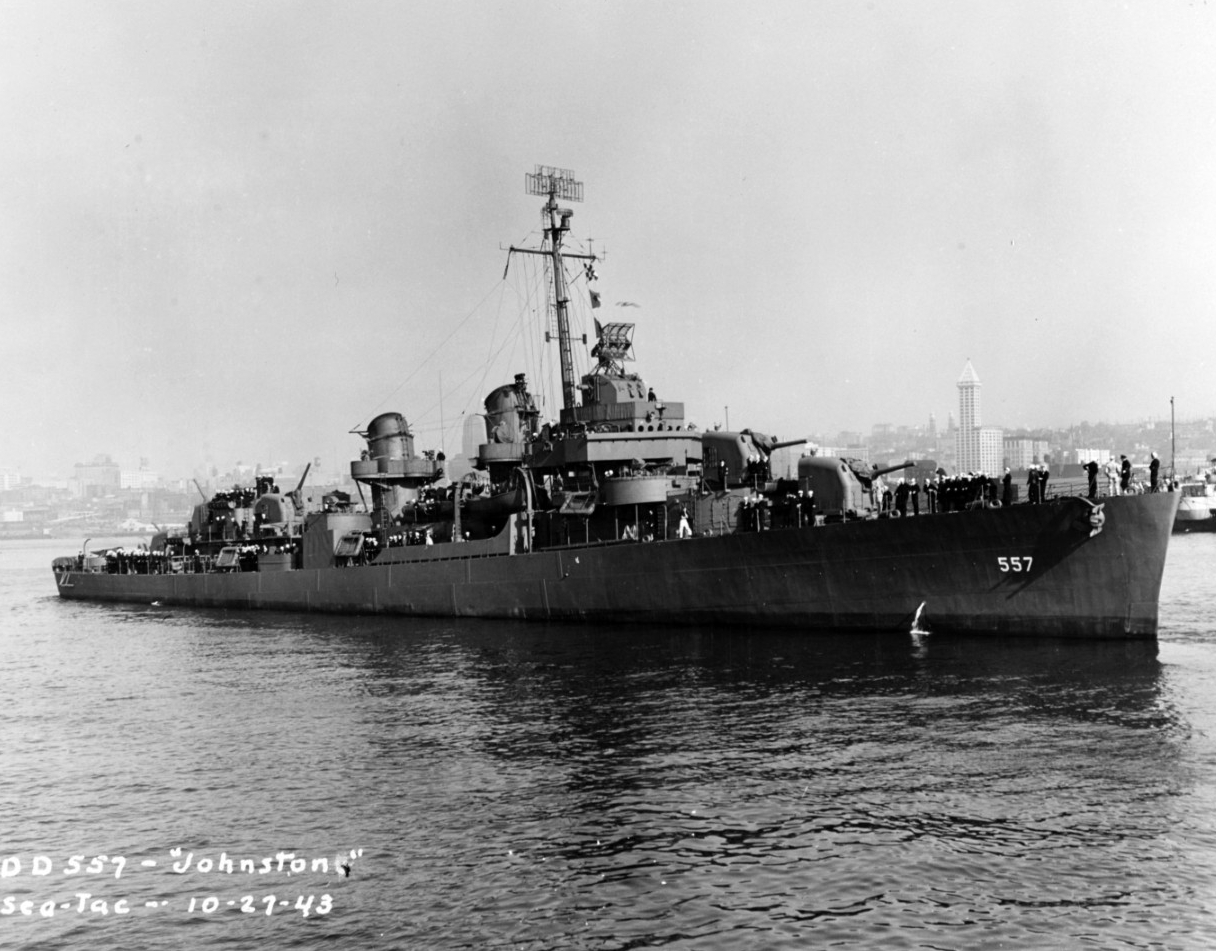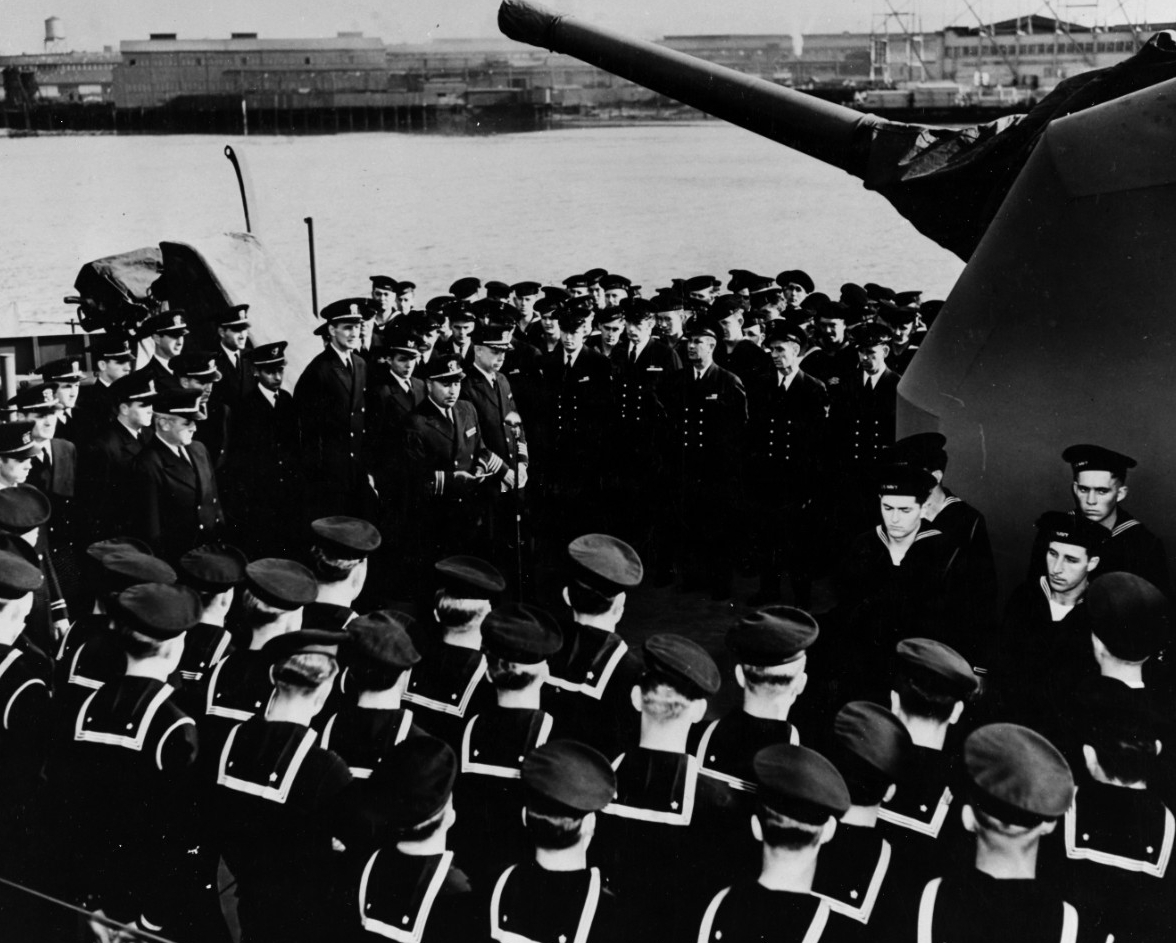Johnston (DD-557)
“This is going to be a fighting ship. I intend to go in harm’s way, and anyone who doesn’t want to go along had better get off right now.” Those were the words of Commander Ernest. E. Evans on the day USS Johnston (DD-557) was commissioned, 27 October 1943, at Seattle, Washington. Just three months later, Johnston was bombarding the beaches of Kwajalein and Eniwetok providing direct support to invasion troops on the ground and conducting antisubmarine patrols off Bougainville.
On Oct. 20, 1944, Johnston joined Seventh Fleet’s Escort Task Unit 77.4—call sign “Taffy 3”—to defend the north Leyte Gulf, east of Samar and off San Bernardino Strait, and the Leyte beachhead for General Douglas MacArthur’s return to the Philippines. On 25 October 1944, a pilot reported the powerful Japanese Center Force steaming into Leyte Gulf heading directly towards Johnston and her small escort carrier task unit. Despite being heavily outmatched, Evans gave the order to attack a major portion of the Japanese fleet. Under a hail of Japanese fire, Johnston fired more than 200 rounds and 10 torpedoes at Japanese heavy cruiser, Kumano, which limped away and survived the battle (she was finally sunk by U.S. carrier aircraft from TF 38 while undergoing repairs in port at Dasol Bay, West Luzon, Philippines, on 25 November 1944). Although Johnston had hit the heavy cruiser, enemy shells managed to strike Johnston as well causing widespread damage and casualties. Evans himself was seriously wounded. Despite the grave damage, no torpedoes remaining, and reduced speed and firepower, Johnston commenced a second attack firing 30 rounds into a 30,000-ton Japanese battleship.
Noticing the Japanese ships were targeting escort carrier Gambier Bay (CVE-73), Evans gave the order to “commence firing on that cruiser, draw her fire on us and away from Gambier Bay.” One by one, Johnston took on Japanese destroyers, although Johnston had no torpedoes and limited firepower. After two-and-a-half hours, Johnston—dead in the water—was surrounded by enemy ships. At 9:45 a.m., Evans gave the order to abandon ship. Twenty-five minutes later, the destroyer rolled over and began to sink.
Of the crew of 327, only 141 survived. Of the 186 lost, about 50 were killed by enemy action, 45 died on rafts from battle injuries and 92, including Evans, were alive in the water after Johnston sank, but were never heard from again.
For Johnston’s supreme courage during the Battle off Samar, she was awarded the Presidential Unit Citation. The ship received six battle stars for service in World War II. Evans posthumously received the Medal of Honor.
“The skipper was a fighting man from the soles of his broad feet to the ends of his straight black hair,” said Ensign Robert C. Hagen, gunnery officer, Johnston. “He was an Oklahoman and proud of the Indian blood he had in him. We called him - though not to his face - 'the Chief.' The Johnston was a fighting ship, but he was the heart and soul of her.”
*****
Additional Resources
Cmdr. Ernest E. Evans, USN
- Cmdr. Ernest Edwin Evans—biography
- Surface Warrior—Remembering Ernest Evans—article from NHHC's blog, The Sextant
- Commander Ernest E. Evans of Johnston (DD-557)— from "World War II Profiles in Duty"
- Ernest E. Evans, Cmdr., USN—U.S. Naval Academy Virtual Memorial Hall
- USS Evans (DE-1043)—Dictionary of American Naval Fighting Ships (DANFS) historical summary of namesake ship
- Contributions of Native Americans to the U.S. Navy
- Oklahoma’s Naval History
The Ship, Her Crew, and the Battle of Leyte Gulf
- Johnston (DD-557)—DANFS historical summary
- On the Offensive Beyond Guadalcanal
- The Battle of Leyte Gulf, 23-26 October 1944
- "Calmness, Courage, and Efficiency": Remembering the Battle of Leyte Gulf
- The Battle off Samar: The Sacrifice of "Taffy 3"
- The Ships of TG 77.4.3
- TG 77.4.3 ("Taffy 3") Presidential Unit Citation and Other Awards
- H-Gram 036 (Special Edition): "No Higher Honor"—The Battle off Samar, 25 October 1944
- H-Gram 038: The Battle of Leyte Gulf
Imagery
- Images of Johnston
- Battle off Samar—image gallery
- Battle of the Surigao Strait—image gallery
- Battle of Leyte Gulf—image gallery




